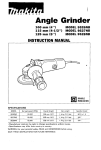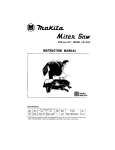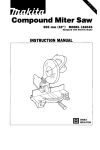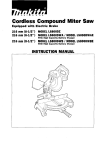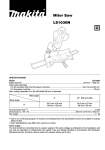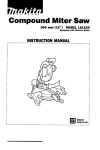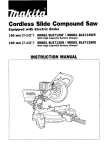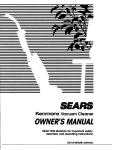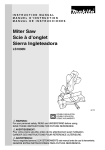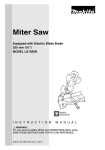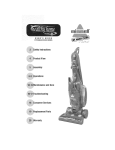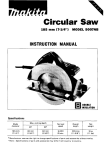Download Makita LSl030N Instruction manual
Transcript
Miter Saw 255 mm (10”) MODEL LSl030N Equipped with Electric Brake INSTRUCTION MANUAL DOUBLE INSU1AT ION r\O U- I 1 No load speed (RPM) 00 45O (left and right) 90.5 m m x 9 5 mm (3-9/16" x 3-3/4") 90.5 mm x 6 7 mm (3-9/16" x 2-5/8") 6 9 m m x 1 3 0 mm (2-3/4" x 5-1/8") I 6 9 m m x 92 mm (2-3/4" x 3-5/8") I ............................................................................. 4,600 5 3 0 mm x 4 7 6 m m x 5 3 2 m m 32" x 18-23/32" x 20-15/16") .................................................... 11.0 kg (24.2 Ibs) Manufacturer reserves the right t o change specifications without notice. Note: Specifications may differ from country t o country. WARNING: For your personal safety, READ and UNDERSTAND before using. SAVE THESE INSTRUCTIONS FOR FUTURE REFERENCE. x 2 For Your Own Safety Read Instruction Manual Before Operating Miter Saw Save it for future reference GENERAL SAFETY PRECAUTIONS (For All Tools) 1. KNOW YOUR POWER TOOL. Read the owner's manual carefully. Learn the tools applications and limitations, as well as the specific potential hazards peculiar to it. 2. KEEP GUARDS IN PLACE and in working order. 3.REMOVE ADJUSTING KEYS AND WRENCHES. Form habit of checking to see that keys and adjusting wrenches are removed from tool before turning it on. 4.KEEP WORK AREA CLEAN. Cluttered areas and benches invite accidents. 5. DON'T USE IN DANGEROUS ENVIRONMENT. Don't use power tools in damp or wet locations, or expose them t o rain. Keep work area well lighted. Don't use tool in presence of flammable liquids or gases. 6. KEEP CHILDREN AWAY. All visitors should be kept safe distance from work area. 7. MAKE WORKSHOP KID PROOF with padlocks, master switches, or by removing starter keys. 8. DON'T FORCE TOOL. It will do the job better and safer at the rate for which it was designed. 9. USE RIGHT TOOL. Don't force tool or attachment t o do a job for which it was not designed. IO. WEAR PROPER APPAREL. Wear no loose clothing, gloves, neckties, rings, bracelets, or other jewelry which may get caught in moving parts. Nonslip footwear is recommended. Wear protective hair covering to contain long hair. 1 1 . ALWAYS USE SAFETY GLASSES. Also use face or dust mask if cutting operation is dusty. Everyday eyeglasses only have impact resistant lenses, they are NOT safety glasses. 12. SECURE WORK. Use clamps or a vise t o hold work when practical. It's safer than using your hand and it frees both hands t o operate tool. 13. DON'T OVERREACH. Keep proper footing and balance at all times. 14.MAINTAIN TOOLS WITH CARE. Keep tools sharp and clean for best and safest performance. Follow instructions for lubricating and changing accessories. 15.DISCONNECT TOOLS before servicing; when changing accessories such as blades, bits, cutters, and the like. 3 16. EXTENSION CORDS. Make sure your extension cord is in good condition. When using an extension cord, be sure t o use one heavy enough t o carry the current your product will draw. An undersized cord will cause a drop in line voltage resulting in loss of power and overheating. Table 1 shows the correct size to use depending on cord length and nameplate ampere rating. If in doubt, use the next heavier gage. The smaller the gage number, the heavier the cord. Minimum gage for cord" Volts 120 V 240 V Ampere Rating I More Than 0 Not Than More 6 12 16 Total length of cord in feet 25 ft. 50 ft. I 50 ft. 100 ft. 100 ft. 200 ft. 150 ft. 300 ft. AWG 18 18 16 14 16 16 16 12 16 14 14 12 Not Recommended 'Only the applicable parts of the Table need to be included. For instance, a 120-volt product need not include the 240-volt heading. 17. REDUCE THE RISK OF UNINTENTIONAL STARTING. Make sure switch is in off position before plugging in. 18. USE RECOMMENDED ACCESSORIES. Consult the owner's manual for recommended accessories. The use of improper accessories may cause risk of injury t o persons. 19. NEVER STAND ON TOOL. Serious injury could occur if the tool is tipped or if the cutting tool is accidentally contacted. 20. CHECK DAMAGED PARTS. Before further use of the tool, a guard or other part that is damaged should be carefully checked t o determine that it will operate properly and perform its intended function - check for alignment of moving parts, binding of moving parts, breakage of parts, mounting, and any other conditions that may affect its operation. A guard or other part that is damaged should be properly repaired or replaced. 21. DIRECTION OF FEED. Feed work into a blade or cutter against the direction of rotation of the blade or cutter only. 22. NEVER LEAVE TOOL RUNNING UNATTENDED. TURN POWER OFF. Don't leave tool until it comes t o a complete stop. 23. When servicing use only identical replacement parts. 24. POLARIZED PLUGS. To reduce the risk of electric shock, this equipment has a polarized plug (one blade is wider than the other). This plug will fit in a polarizedoutlet only one way. If the plug does not fit fully in the outlet, reverse the plug. If it still does not fit, contact a qualified electrician to install the proper outlet. Do not change the plug in any way. 4 VOLTAGE WARNING: Before connecting the tool t o a power source (receptacle, outlet, etc.) be sure the voltage supplied is the same as that specified on the nameplate of the tool. A power source with voltage greater than that specified for the tool can result in SERIOUS INJURY t o the user - as well as damage to the tool. If in doubt, DO NOT PLUG IN THE TOOL. Using a power source with voltage less than the nameplate rating is harmful t o the motor. ADDITIONAL SAFETY RULES 1. Wear eye protection. 2. Do not operate saw without guards in place. 3.Don't use the tool in the presence of flammable liquids or gases. 4. Check the blade carefully for cracks or damage before operation. Replace cracked or damaged blade immediately. 5. Use only flanges specified for this tool. 6. Be careful not to damage the arbor, flanges (especially the installing surface) or bolt. Damage t o these parts could result in blade breakage. 7. Make sure that the turn base is properly secured so it will not move during operation. 8. For your safety, remove the chips, small pieces, etc. from the table top before operation. 9. Avoid cutting nails. Inspect for and remove all nails from the workpiece before operation. IO. Make sure the shaft lock is released before the switch is turned on. 11. Be sure that the blade does not contact the turn base in the lowest position. 12. Hold the handle firmly. Be aware that the saw moves up or down slightly during start-up and stopping. 13. Do not perform any operation freehand. The workpiece must be secured firmly against the turn base and guide fence during all operations. 14. Keep hands out of path of saw blade. Avoid contact with any coasting blade. It can still cause severe injury. 15. Never reach around saw blade. 16. Make sure the blade is not contacting the workpiece before the switch is turned on. 17. Before using the tool on an actual workpiece, let it run for a while. Watch for vibration or wobbling that could indicate poor installation or a poorly balanced blade. 18. Wait until the blade attains full speed before cutting. 19. Stop operation immediately if you notice anything abnormal. 20. Do not attempt t o lock the trigger in the on position. 5 21. Shut off power and wait for saw blade t o stop before servicing or adjusting tool. 22. Be alert at all times, especially during repetitive, monotonous operations. Don't be lulled into a false sense of security. Blades are extremely unforgiving. 23. Do not cut cross-armed as shown I 24. Always use accessories recommended in this manual. Use of improper accessories such as abrasive wheels may cause an injury. 25. Don't abuse cord. Never yank cord t o disconnect it from the receptacle. Keep cord away from heat, oil, water and sharp edges. SAVE THESE INSTRUCTIONS. 6 When carrying the tool, lower the handle fully and press the stopper pin to lock the handle in the lowered position. Secure the turn base by means of the grip. The tool can then be conveniently carried by the carrying grip. Carrying WARNING: Be sure that the tool is unplugged first. Stopper pin is for carrying purposes only and not for any cutting operations. Bench mounting miter saw This tool should be bolted with two bolts to a level and stable surface using the bolt holes provided in the tool's base. This will help prevent tipping and possible injury. Removing or installing saw blade CAUTION: Always be sure that the tool is switched off and unplugged before removing or installing the blade. To remove the blade, use the socket wrench to loosen the hex bolt holding the center cover by turning it more than three turns counterclockwise. Raise the safety cover and center cover Socket wrench 7 Press the shaft lock so that the blade cannot revolve and use the socket wrench to loosen the hex bolt clockwise. Then remove the hex bolt, outer flange and blade. Socket wrench To install the blade, mount the blade onto the spindle, making sure that the direction of the arrow on the surface of the blade matches the direction of the arrow on the blade case. Install the outer flange and hex bolt, and then use the socket wrench to tighten the hex bolt securely counterclockwise while pressing the shaft lock. Then tighten the hex bolt clockwise to secure the center cover. CAUTION: Use only the Makita socket wrench provided to install or remove the blade. Failure to do so may result in overtightening or insufficient tightening of the hex bolt. This could cause an injury. Safety cover When lowering the handle, the safety cover rises automatically. The cover returns to its original position when the cut is completed and the handle is raised. NEVER DEFEAT OR REMOVE THE SAFETY COVER. In the interest of your personal safety, always maintain the safety cover in good condition. Any irregular operation of the safety cover should be corrected immediately. NEVER USE THE TOOL WITH A FAULTY SAFETY COVER. If the seethrough safety cover becomes dirty, or sawdust adheres to it in such a way that the blade and/or workpiece is no longer easily visible, unplug the saw and clean the cover carefully with a damp cloth. Do not use solvents or any petroleum-based cleaners on the plastic cover. 8 Dust bag The use of the dust bag makes cutting operations clean and dust collections easy. To attach the dust bag, fit the bags entry port over the dust spout. When the dust bag is about half full, remove the dust bag from the tool and pull the fastener out. Empty the dust bag of its contents, tapping it lightly so as to remove particles adhering to the insides which might hamper further collection. Switch action To prevent the trigger from being accidentally pulled, a lock-off button is provided. To start the tool, press in the lock-off button and pull the trigger. Release the trigger to stop. Lock-off button CAUTION: *Before plugging in the tool, always check to see that the switch trigger actuates properly and returns to the "OFF" position when released. .When not using the tool, remove the lock-off button and store it in a secure place. This prevents unauthorized operation. .Do not pull the trigger hard without pressing in the lock-off button. This can cause breakage of the switch. 9 Kerf board This tool is provided with the kerf board in the turn base. If the kerf groove has not yet been cut in the kerf board by the factory, you should cut the groove before actually using the tool to cut a workpiece. Switch on the tool and lower the blade gently to cut a groove in the kerf board. Maintaining maximum cutting capacity Unplug the tool before any adjustment is attempted. This tool is factory adjusted to provide the max. cutting capacity for a 255 mm (10") saw blade. When the diameter of the blade has been reduced due to sharpening, adjust the depth adjusting bolt by turning it with the socket wrench. The saw blade is lowered by turning the depth adjusting bolt counterclockwise and raised by turning it clockwise. Adjust so that when the handle is in the fully lowered position, there will be a distance of about 130 m m (5-1/8") from the front face of the guide fence to the point where the front edge of the blade enters the kerf. With the tool unplugged, rotate the blade by hand while holding the handle all the way down. Be sure that the blade does not contact any part of the Positioningfor adjusting the miter angle Loosen the grip by turning counterclockwise. Turn the turn base while pressing down the latch spring. When you have moved the grip to the position where the pointer indicates the desired angle on the miter scale, securely tighten the grip clockwise. CAUTION: When turning the turn base, be sure to raise the handle fully. 10 Securing workpiece Whenever possible, secure the workpiece with the optional vise. If you must use your hand to hold the workpiece, then it must be done firmly and securely so as not to lose control of the workpiece. Your hand and arm must be kept well away from the blade area (4" minimum). Squeeze the workpiece firmly against the guide fence with your fingers held over the top of the guide fence. The workpiece must also rest steadily on the turn base. WARNING: Never use your hand to hold the workpiece that requires your hand to be any closer than 4" from the blade area. In this case, always use the optional vise to secure the workpiece. After any cutting operation, raise the blade gently. Never raise the blade until it has come to a complete stop. Serious injury may result. 1. Vertical vise (optional accessory) The vertical vise can be installed on the guide fence or the holder assembly (optional accessory). Insert the vise rod into the hole in the 7 Clamp screw Vise rodguide fence or holder assembly and tighten the screw to secure the vise rod. Position the vise arm according to the thickness and shape of the workpiece and secure the vise arm by tightening the screw. Press the workpiece flat against the guide fence and the turn base. Position of the workpiece a t the desired cutting position and secure it firmly by tightening the clamp screw. 1 2. Horizontal vise (optional accessory) The horizontal vise can be installed on either the left or right side of the base. When performing 15" or greater miter cuts, install the horizontal vise on the side opposite the direction in which the turn table is to be turned. By turning the knob on the vise counterclockwise, the screw is released and the vise shaft can be moved rapidly in and out. By turning the knob clockwise, the screw remains secured. To grip workpieces, turn the knob gently clockwise until the projection reaches it topmost position, then fasten securely. If the knob is forced in or pulled out while being turned clockwise, the projection may stop a t an angle. In this case, turn the knob back counterclockwise until the screw is released, before turning again gently clockwise. 11 3. Holders and holder assembly I (optional accessories) The holders and the holder assembly can be installed on either side as a convenient means of supporting workpieces horizontally. Install them as shown in the figure. Then tighten the screws firmly to secure the holders and the holder assembly. Screw Holder assembl When cutting long workpieces, use the holder-rod assembly (optional accessory). It consists of two holder assemblies and two rods 12. Screw Holder assembly 1 Rod 12 CAUTION: Always support long workpieces level with the top surface of the turn base for accurate cuts and to prevent dangerous loss of control of the tool. Operation CAUTlON: *Before use, be sure to release the handle from the lowered position by pulling the stopper pin. *Make sure the blade is not contacting the workpiece, etc. before the switch is turned on. *Do not apply excessive pressure on the handle when cutting. Too much force may result in overload of the motor and/or decreased cutting efficiency. *Gently press down the handle to perform the cut. If the handle is pressed down with force or if lateral force is applied, the blade will vibrate and leave a mark (saw mark) in the workpiece and the precision of the cut will be impaired. 12 When cutting with this tool, the thickness of the blade is cut out of the workpiece as well. Therefore, your cutting line should be on either the left or right side of the groove in the kerf board. Switch on the tool and wait until the blade attains full speed before lowering gently into the cut. When the blade, contacts the workpiece, gradually bear down on the handle to perform the cut. When the cut is completed, switch off the tool and WAIT UNTIL THE BLADE HAS COME TO A COMPLETE STOP before returning the blade to its fully elevated position . A thin piece of cut off material could Cutting line G ~ M ? CAUTION: When cutting long workpieces, use supports that are as high as the top surface level of the turn base. 1. Cutting crown and cove moldings *Crown and cove molding can be cut on a compound cut with the moldings laid flat on the turn base. *There are two common types of crown moldings and one type of cove molding; 52/38" wall angle crown molding, 45" wall angle crown molding and 45" wall angle cove molding. See illustrations below. Ceiling - 2 Ceiling Ceiling - 3 45" type cove molding 13 *There are crown and cove molding joints to fit "Inside" 90" corners and "Outside" 90" corners t@ and @ in Fig. A). (aand 0in Fig. A) * Outside corner / Room 1 Ceiling Wall Fig. (B) . Position crown molding with its WALL CONTACT EDGE against the guide fence and its CEILING CONTACT EDGE against the crown molding stopper as shown in Fig. (B). Refer to the table (C) for the miter angle. Table For inside corner Miter angle Finished piece 0 Right 45" Save the right side of blade Q 0 14 (CI Position in Fig (A) -- I aft AKO Save the left side of blade Save the right side of blade 2. Cutting aluminum extrusion When securing aluminum extrusions, use spacer blocks or pieces of scrap as shown in the figure to prevent deformation of the aluminum. Use a cutting lubricant when cutting the aluminum extrusion to prevent build-up of the aluminum material on the blade. I n - Aluminum extrusion I Spacer block CAUTIO N: Never attempt to cut thick or round aluminum extrusions. Thick aluminum extrusions may come loose during operation and round aluminum extrusion cannot be secured firmly with this tool. 3. Wood facing Use of wood facing helps to assure splinter-free cuts in workpieces. Attach a wood facing to the guide fence using the holes in the guide fence. CAUTION: *Use straight wood of even thickness as the wood facing. *See the figure below concerning the dimensions for a suggested wood facing Over 10 m m (3/8") Over 460 mm (18-1/8") 90 mm (3-9/16") 137" 70" 70" 137" (5-3/8") (2-3/4") (2-3/4") (5-3/8") Hole Center of wood facing 15 4. Cutting repetitive lengths When cutting several pieces of stock to the same length, ranging from 240 m m (9-29/64") to 400 m m (15-3/4"), use of the set plate (optional accessory) will facilitate more efficient operation. Install the set plate on the holder (optional accessory) as shown in the figure. Align the cutting line on your workpiece with either the left or right side of the groove in the kerf board, and while holding the workpiece from moving, move the set Holder / plate flush against the end of the workpiece. Then secure the set plate with the screw. When the set plate is not used, loosen the screw and turn the set plate out of the way. 16 MAINTENANCE CAUTION: Always be sure that the tool is switched off and unplugged before attempting to perform inspection or maintenance. WARN I NG: Always be sure that the blade is sharp and clean for the best and safest performance. Alignment for squareness This tool was carefully adjusted and aligned for squareness of cut at the factory, but rough handling may have affected the alignment. If your tool is not aligned properly, perform the following. Loosen the grip and set the turn base at zero degrees by turning the turn base. Tighten the grip securely and loosen the hex bolts on the guide fence. Square the side of the blade with the face of the guide fence using a triangular rule, try-square, etc. by moving the right side of the guide fence. Then securely tighten the hex bolts on the guide fence in the order indicated in the figure. - Triangular rule Iw 'c\ Guide fence I Y G r l N wr p \ Replacing carbon brushes Remove and check the carbon brushes regularly. Replace when they wear down to the limit mark. Keep the carbon brushes clean and free to slip in the holders. Both carbon brushes should be replaced at the same time. Use only identical carbon brushes. L Limit mark 17 Use a screwdriver to remove the brush holder caps. Take out the worn carbon brushes, insert the new ones and secure the brush holder caps. I After use After use, wipe off chips and dust adhering to the tool with a cloth or the like. Keep the safety cover clean according to the direction in the previously covered "Safety cover". Lubricate the sliding portions with machine oil to prevent rust. To maintain product SAFETY and RELIABILITY, repairs, any other maintenance or adjustment should be performed by Makita Authorized or Factory Service Centers, always using Makita replacement parts. 18 ACCESSORIES The accessories listed inthis manual are available an extra-cost from your Makita distributor or Makita factory service center. Service centers are listed on the warranty card packed with your tool. CAUTION: These accessories or attachments are recommended for use with your Makita tool specified in this manual. The use of any other accessories or attachments might present a risk of injury to persons. The accessories or attachments should be usded only in the proper and intended manner. .Socket wrench 13 Dust bag Part No. 782212-4 Part No. 122523-9 Lock-off button (2 pcs.) *Triangular rule a Part No. 762001-3 Part No. 41 1478-6 Set plate Holder-rod assembly Part No. 122472-0 Carbide-tippedsaw blade Cross-cut saw blade Hole dia. Dia. Immi Hole dia Part No. b" teeth 721425-2 255 (10") 15 88 (5/8") 104 *Crown molding stopper set Part No. 192622-1 Part No teeth *Holder set (with screws) Part No. 192621-3 19 Holder assembly Vertical vise (with screw) Part No. 122446-1 Part No. 192672-6 n Horizontal vise Part No. 122564-5 20 May-26-'98 US 255 m m (IO") MITER SAW Model LS1030N 'P 21 y 7 5 y76 ,77 Note: The switch and other part configurations may differ from country to country. 22 May-26-'98 MODEL LS1030N 'AtMAtD 5 6 7 8 9 10 11 12 13 14 15 16 17 18 19 20 21 22 23 24 25 26 27 28 29 30 31 32 33 34 35 36 37 38 39 40 41 ~ 2 Handle Cover Ball Bearing 6202LLB Flat Washer 15 Shaft Lock Fan 80 ARMATURE ASSEMBLY IWith Item 2 3 5 7 & 81 Insulation Washer Ball Bearing 6000LLB Faffle Plate FIELD ASSEMBLY Tapping Screw 4x18 Strain Relief Cord Cord Guard Name Plate Tapping Screw 4x18 Pan Head Screw M6x60 Switch Button Brush Holder Cap Carbon Brush Motor Housing Complete Switch Compression Spring 3 Lock Off Lever Switch Lever Cam Tapping Screw Flange PT 5 x 6 5 1 1 1 1 Compression Spring 9 Hex Bolt M8x75 Rubber Sleeve 6 Blade Case Complete 1 1 1 1 1 1 1 1 1 1 Tapping Screw 4x18 Makita Mark Guide Cover Helical Gear 42 Bearing Box Ball Bearing 6203LLB Bearing Retainer 6 4 Spindle Flange 53 Flange 53 1 1 1 1 1 1 1 1 1 1 2 1 1 1 1 5 4 1 2 1 1 1 1 1 1 1 - DESCRIPTION MACHINE MACHINE _______ 1 2 3 4 AD: OESCRIPTION US 1 1 1 1 1 1 1 1 1 2 1 1 1 1 1 1 1 1 1 1 1 1 1 1 1 2 2 1 42 43 44 45 46 47 48 49 50 51 52 53 54 55 56 57 58 59 60 61 62 63 64 1 1 1 1 1 4 1 1 1 1 1 2 1 3 Kerf Board Hex Bolt Max40 Guide Fence Turn Base Base Complete Knock Spring Grip 32 Pan Head Screw M5x12 Hex Bolt M8x30 Slide Plate 68 69 70 71 72 73 74 Compression Spring 28 Spring Holder P," 8 Sleeve 8 Rod 16 stopper Pln 0 Ring 5 Hex Socket Head Bolt M10x35 Spring Washer 10 Arm P," 5 Flat Washer 8 Hex Lock Nut M 8 - 1 3 Kerf Board 65 66 67 75 76 77 78 79 BO 81 82 83 Hex Flange Head Bolt Max20 center Plate center Cover Hex Flange Head Bolt M 8 x l 2 Torsion Spring 36 Safety cover Flat Washer 5 Pan Head Screw M5x12 Hex Socket Head Bolt M 6 Pan Head Screw M5x16 Hex. Socket Head Bolt M6x10 Ring 7 Flat Washer 7 Hex Socket Button Head Bolt M 6 Link Plate Hex Socket Button Head Bolt M 6 Flat Washer 7 Ring 7 Note The switch and other part Specifications may differ from country t o country 23 MAKmA LIMITED ONE YEAR WARRANTY Warranty Policy Every Makita tool is thoroughly inspected and tested before leaving the factory. It is warranted t o be free of defects from workmanship and materials for the period of ONE YEAR from the date of original purchase. Should any trouble develop during this one-year period, return the COMPLETE tool, freight prepaid, t o one of Makita’s Factory or Authorized Service Centers. If inspection shows the trouble is caused by defective workmanship or material, Makita will repair (or at our option, replace) without charge. This Warranty does not apply where: repairs have been made or attempted by others: repairs are required because of normal wear and tear : 0 The tool has been abused, misused or improperly maintained; alterations have been made t o the tool. IN NO EVENT SHALL MAKITA BE LIABLE FOR ANY INDIRECT, INCIDENTAL OR CONSEQUENTIAL DAMAGES FROM THE SALE OR USE OF THE PRODUCT. THIS DISCLAIMER APPLIES BOTH DURING AND AFTER THE TERM O F THIS WARRANTY. MAKITA DISCLAIMS LIABILITY FOR ANY IMPLIED WARRANTIES, INCLUDING IMPLIED WARRANTIES OF “MERCHANTABILITY” AND “FITNESS FOR A SPECIFIC PURPOSE,” AFTER THE ONE-YEAR TERM O F THIS WARRANTY. This Warranty gives you specific legal rights, and you may also have other rights which vary from state to state. Some states d o not allow the exclusion or limitation of incidental or consequential damages, so the above limitation or exclusion may not apply t o you. Some states do not allow limitation on how long an implied warranty lasts, so the above limitation may not apply to you. Makita Corporation 3-11-8, Sumiyoshi-cho, Anjo, Aichi 446-8502 Japan 884146-995 PRINTED IN JAPAN 1998 - 6 - N
























